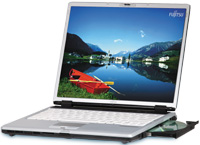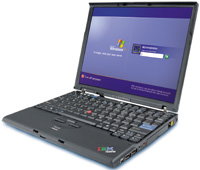Laptop computers are hotter than ever – in more ways than one. As their power increases, so does the heat they generate, to the point where many cannot sit comfortably on a lap for any amount of time.
Nonetheless, Bear Stearns analysts think that laptop shipments will top desktops by late 2007 or early 2008 in some markets (primarily the U.S. and western Europe), propelled in large part by consumer demand. IDC predicts a 20 per cent compound annual growth rate for consumer notebooks and 15 per cent in corporate units over the 2005 to 2010 period.
The most popular machines are the so-called thin-and-light units, which include systems up to 5 lb. (2.27 kg.) Those are the ones we chose to put under the microscope. We gathered five machines, ranging in weight from a dainty 2.7 lb to a relatively hefty 4.5 lb. All but two were dual core systems.
Each unit ran Windows XP Professional, brought up to the current Microsoft patch level, and was performance tested using FutureMark’s PCMark05 benchmarking software. Battery life was measured with wireless networking enabled, since, in most cases, that’s how these machines will be used.
As always, prices are list, in Canadian dollars.
LG T1 Express Dual |
 |
The widescreen T1 is one of the heavier models in our roundup. Its 14.1-inch display is bright and clear, and manages not only to give the best graphics performance in the group, but to do so while aggressive power management provided the second best battery life at just over four hours.
The unit itself is, well, shiny. The top is shiny black (and easily marred by fingerprints and scratches), and inside the keyboard area is shiny white, with broad flat white keys. The touch is not entirely to my taste, though many will like it, and the keyboard size means large hands have no problems.
A dual layer DVD-RW drive occupies one side, and the usual complement of ports is scattered around: three USB, audio, video, modem, Gigabit Ethernet, IEEE 1394 and Bluetooth. A five-in-one card slot (XD/SD/MMC/MS/MS Pro) and an ExpressCard/34 slot, 1 GB of RAM and a 60 GB hard drive round out the configuration.
Fujitsu LifeBook S7110 |
 |
The S7110 comes with 512 MB RAM, a 100 GB hard drive and a gorgeous 14.1-inch display. As well, you get an integrated dual layer DVD writer, wireless 802.11 a/b/g, Bluetooth, modem and Gigabit Ethernet. There are three standard USB 2.0 ports, VGA, Infrared, IEEE 1394, microphone, headset, and mini S-video connections, PC Card, ExpressCard and SD card slots.
Battery life, as one would expect from such a large screen, was not so great, clocking in at two and a half hours. But performance blew the socks off everyone else.
I don’t care for the rather flat keyboard. It’s spacious enough for the largest of fingers, but the touch doesn’t suit me. Keyboards, however, are a personal thing; your mileage may vary.
Fujitsu offers a three year warranty on this model.
HP Compaq nc2400 |
 |
The nc2400 may not be a performance system, but in battery life it topped the lot by a landslide, managing a whopping six hours of life from its nine cell battery. Both of these facts may be partly a result of it being one of the two single core systems in the roundup (and the three extra cells in its battery helped a lot). It has 1 GB RAM and a 60 GB hard drive. Our review model came with a docking station and two A/C adapters.
The 12.1-inch screen wasn’t as easy to read as some of the others, with text appearing thin and wispy. The keyboard, although small, is well laid out and easy to type on. The pointing device is a trackstick; all but HP and Lenovo offer either a touchpad alone or both touchpad and trackstick.
To keep the system’s footprint small, the battery bulges out of the back, acting like a handy foot to prop it up to an ideal typing angle. The ports are scattered around the periphery: Two USB ports, VGA, Gigabit Ethernet, modem and so forth are all present. And, there’s an integrated DVD writer.
A touch-sensitive strip above the keyboard offers volume control, a wireless on/off switch and Presentation Mode, which optimizes the system setting for those PowerPoint moments.
Lenovo ThinkPad X60 |
 |
The X60 carries on the ThinkPad tradition, with its characteristic styling, good keyboard and trackstick pointing device. This unit comes with 512 MB RAM and an 80 GB SATA hard drive. Like the other smaller machines, its screen is 12.1 inches. Video quality was very good.
The system is loaded in the communications department, with Gigabit Ethernet, modem, 802.11a/b/g wireless, and Bluetooth. However, it has no optical drive, either internal or external. You’ll have to purchase one as an accessory.
Battery life was average with the standard 8 cell battery, clocking in around the three hour mark.
Performance on the benchmarks was excellent – second only to Fujitsu – with especially good CPU and memory scores. |
Toshiba Portégé R200 |
 |
The R200 gave the third best battery life, at three and a half hours, but it came in last in the performance ratings. It’s a single core Pentium M, with 512 MB RAM and a 60 GB hard drive. Communications capabilities include 802.11b/g wireless, Gigabit Ethernet, and modem; a Bluetooth antenna is built in, but Bluetooth is not installed.
The port collection consists of three USB ports, the aforementioned modem and network jacks, external video, audio, and there are slots for SD cards and PC cards. There is no optical drive; Toshiba offers a number of options as accessories.
The keyboard is pleasant to the touch, and the 12.1 inch screen is bright and clear.
The Bottom Line
There’s always a tradeoff when you look at the smallest, lightest machines on the market. In scoring portability, we looked at not only the base weight of the machine, but what was included in that package.
For example, a 2-lb machine may be, in the long run, inferior to a 4-lb machine if you have to carry a dozen other bits and pieces (optical drive, cables, adapters, etc.) to get the functionality you need whether on the road or in the office.
It’s particularly disappointing to see systems with no optical drive whose only backup of the operating system and utilities is on a hard drive partition. That makes it vulnerable until (you guessed it) it’s cut to optical media. What’s wrong with this picture?
You’ll notice that most of the dual core systems pay a price in battery life, and don’t seem to have appreciably higher performance. The big wins will come when applications are multi-threaded, and most business apps are not, yet.
Fingerprint readers
All of our systems have fingerprint readers, which vendors hope will add that extra layer of security demanded by our paranoid times.
Using them, however, can be, well, interesting. I tried for half an hour to get four consecutive acceptable swipes on one system (it won’t register your fingerprint until you do), and only did so once.
I don’t think I’d forego passwords completely just yet. That said, the incremental cost is small, so the reader is a good addition to a laptop.
It’s great to see that all of the machines came with three-year warranties. Many also came with at least an evaluation copy of an anti-virus program, plus utilities to manage wireless and such.
Toshiba’s little guy, for all its lightness, felt like last year’s model beside the shiny new Core Duo, Bluetooth-enabled systems. It had great battery life and a nice keyboard, but its lack of optical drive and lackluster performance cost it.
Average power
Lenovo’s battery life was average in this group, although the machine itself did have a slight weight advantage.
It is ThinkPad-solid, and its memory and CPU performance topped the group. Lack of an optical drive (except as a separately-purchased accessory) was a big minus.
Fujitsu, despite its weight, is a loaded system with surprising performance. Its battery life was rather wimpy, however.
HP tied with Fujitsu in points. Its battery life was amazing and it has an integrated optical drive plus an included docking station, but its performance score was fourth of the five machines and its display didn’t stack up as well as the others.
LG climbed to the top of the heap with its ubiquitous connectivity, very good battery life (especially given its screen size) and gorgeous display. It was not the top performer, but it was no lower than third in each category and its price makes it one heck of a deal. I just wish it were a little less shiny.